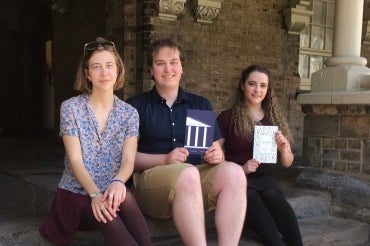Work on an academic journal in U of T humanities, become a better writer

Published: May 18, 2017
For students working on a myriad of academic journals available at U of T, it's a chance to pick up editing skills that ultimately improve their own writing.
“IDIOM receives upward of 100 submissions each year,” says Dina Ginzburg, assistant editor-in-chief of U of T's English undergraduate academic journal. “Having to read through so many essays and having specific things to say about each one has trained me to quickly recognize good and bad writing, faulty logic and clunky arguments – in short, it has made me a more aware editor and a better writer.”
Willem Crispin-Frei, a fourth-year student who is majoring in classics with a double minor in classical civilization and urban studies agrees. Being editor-in-chief of Plebeian, the undergraduate classics journal “has certainly gotten me to be more thorough when editing my own papers.”
The two editors are among dozens of undergraduate students who have gained valuable experience from producing an academic journal. The Faculty of Arts & Science boasts more than a half-dozen such journals, in fields as diverse as classics and cinema studies.
Professor Donald Ainslie, principal of University College and provostial adviser on undergraduate humanities education, believes students learn valuable lessons in contributing to and creating academic journals.
“The various undergraduate journals take students’ research experiences in the humanities to the next level,” Ainslie said. “They give them the opportunity to experience the broader research context of submitting independently developed essays, revising them in light of peer critique and ultimately sharing their ideas with the broader public in published form.
“The students who run these journals also get to experience the other side of humanities research: the refereeing of papers, offering suggestions for revisions and assessing whether those revisions yield a paper with insights deserving a broader audience.”
Read more about humanities at U of T
In the age of digitization, many of the journals are posted online but printed as well. Ginzburg believes that having a printed journal makes it feel more “real.”
“Many of our authors work with books and theories that were published long before online publishing began. It would seem horribly indecent to publish their work exclusively online. It just would not do justice to their sources.”
The collaborative aspect of creating an academic journal is something students find appealing.
“Brainstorming with my team to figure out our theme, our goals for the journal and how we’re going to reach out to people in our call for submissions was one of the things I enjoyed most,” said Priyanka Pai Kochikar, who is pursuing a double major in literature & critical theory and political science, and is an editor of FUN, the journal of the Literature and Critical Theory Student Union. “Honestly, those initial planning stages are so great and just as satisfying as the feeling of having the first proof of the journal in our hands.”
Lola Borissenko is a fourth-year student majoring in cinema studies and English with a minor in history. The editor-in-chief of Camera Stylo, the journal of the Cinema Studies Students’ Union, says that the teamwork involved in putting a journal together can be a real learning opportunity.
“My biggest learning experience stemmed from all the collaborative work I had to do during the pre- and post-production phases,” she said. “Communicating with designers, editors, authors, our academic adviser and the printing company was quite a challenge.”
For a number of the students, working on an academic journal helped them explore a career choice or offered them an option that they hadn’t seriously considered.
Some like the IDIOM's Erin Church dream of working in publishing. Others like Borissenko are looking toward pursuing academic careers.



